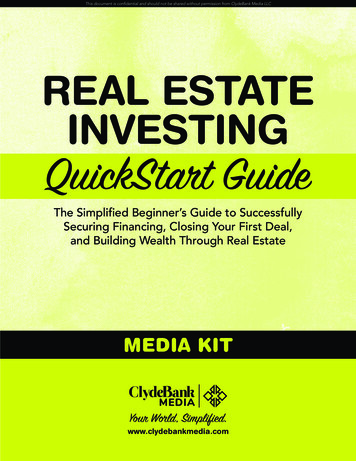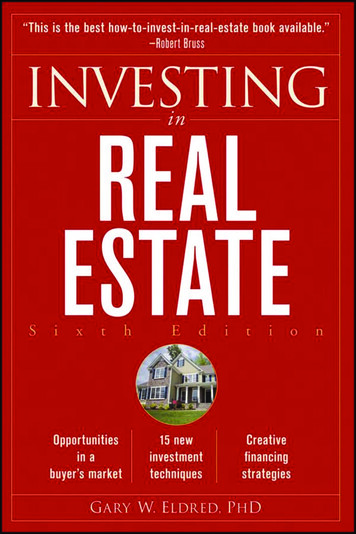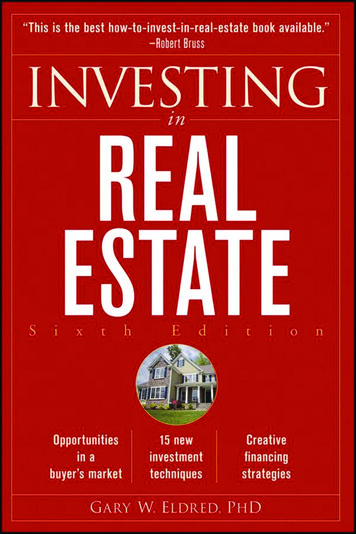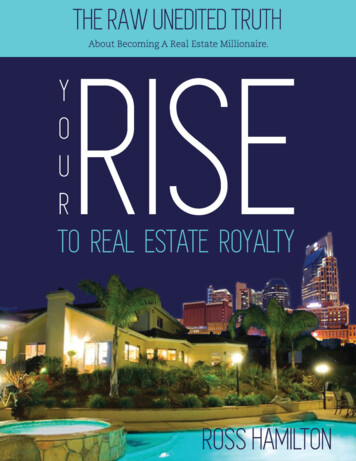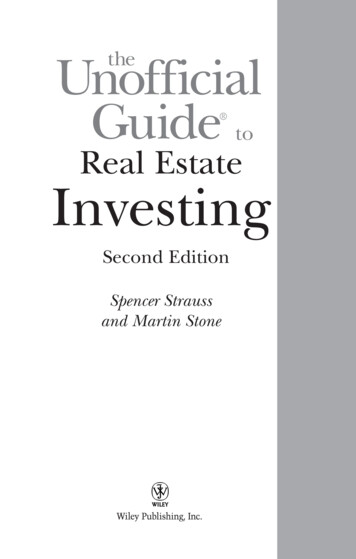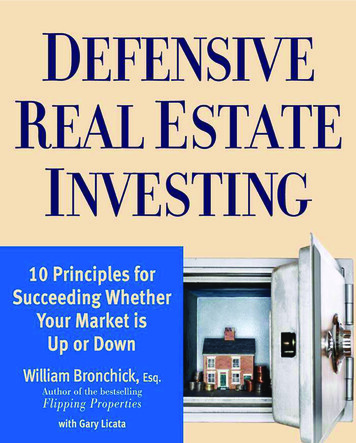
Transcription
FM FINAL.qxp3/15/073:50 PMPage iDEFENSIVEREAL ESTATEINVESTING
index FINAL.qxp3/15/073:49 PMPage 258
FM FINAL.qxp3/15/073:50 PMPage iiiDEFENSIVEREAL ESTATEINVESTING10 Principles for SucceedingWhether Your Market is Up or DownWilliam Bronchick, Esq.With Gary R. LicataPU B L I S H I NGNew York
FM FINAL.qxp3/15/073:50 PMPage ivThis publication is designed to provide accurate and authoritative information inregard to the subject matter covered. It is sold with the understanding that the publisheris not engaged in rendering legal, accounting, or other professional service. Iflegal advice or other expert assistance is required, the services of a competent professionalperson should be sought.Editorial Director: Jennifer FarthingDevelopment Editor: Joshua MartinoProduction Editor: Julio EspinTypesetting: Black Diamond GraphicsCover Design: Rod Hernandez 2007 by William Bronchick, Gary LicataPublished by Kaplan PublishingA Division of Kaplan Inc.All rights reserved. The text of this publication, or any part thereof, may not be reproducedin any manner whatsoever without written permission from the publisher.Printed in the United States of AmericaMay 200707 08 09 10 9 8 7 6 5 4 3 2 1ISBN 13: 978-1-4277-5463-9ISBN 10: 1-4277-5463-2Kaplan Publishing books are available at special quantity discounts to use for salespromotions, employee premiums, or educational purposes. Please email our SpecialSales Department to order or for more information at kaplanpublishing@kaplan.com,or write to Kaplan Publishing, 888 7th Avenue, 22nd Floor, New York, NY 10106.
FM FINAL.qxp3/15/073:50 PMPage vContentsPreface . . . . . . . . . . . . . . . . . . . . . . . . . . . . . . . . . . . . . . . . . . . . . . . . . . . . . . . . . . . viiIntroduction . . . . . . . . . . . . . . . . . . . . . . . . . . . . . . . . . . . . . . . . . . . . . . . . . . . . . . . ixCHAPTER 1: Don’t Try to Get Rich Quick . . . . . . . . . . . . . . . . . . . . . . 1Getting Rich in Real Estate Isn’t Easy or Instant . . . . . . . . . . . . . . . . . . . . . . . . 1Start with Realistic Goals and Expectations . . . . . . . . . . . . . . . . . . . . . . . . . . . . 3Developing Skills Takes Time . . . . . . . . . . . . . . . . . . . . . . . . . . . . . . . . . . . . . . . 5Success Requires Education plus Action . . . . . . . . . . . . . . . . . . . . . . . . . . . . . . 6Key Points to Remember . . . . . . . . . . . . . . . . . . . . . . . . . . . . . . . . . . . . . . . . . . 8CHAPTER 2: You Can Profit in Any Market, But You MustKnow Your Market . . . . . . . . . . . . . . . . . . . . . . . . . . . . . . 9What Determines the Market? . . . . . . . . . . . . . . . . . . . . . . . . . . . . . . . . . . . . . 10Analyzing Your Market . . . . . . . . . . . . . . . . . . . . . . . . . . . . . . . . . . . . . . . . . . . 13What’s Right for You? . . . . . . . . . . . . . . . . . . . . . . . . . . . . . . . . . . . . . . . . . . . . 25Key Points to Remember . . . . . . . . . . . . . . . . . . . . . . . . . . . . . . . . . . . . . . . . . 27CHAPTER 3: Learn How to Valuate a Property. . . . . . . . . . . . . . . . . . 29The Art and Science of Valuating a Property . . . . . . . . . . . . . . . . . . . . . . . . . . 29Key Points to Remember . . . . . . . . . . . . . . . . . . . . . . . . . . . . . . . . . . . . . . . . . 43CHAPTER 4: Determine Your Profit before You Buy . . . . . . . . . . . . . 45The Past Doesn’t Equal the Future . . . . . . . . . . . . . . . . . . . . . . . . . . . . . . . . . . 45Find Motivated Sellers . . . . . . . . . . . . . . . . . . . . . . . . . . . . . . . . . . . . . . . . . . . 47How to Analyze a Potential Deal . . . . . . . . . . . . . . . . . . . . . . . . . . . . . . . . . . . 48CLEAR System of Analyzing Deals . . . . . . . . . . . . . . . . . . . . . . . . . . . . . . . . . . 49Balance Your Business with Your Personal Goals . . . . . . . . . . . . . . . . . . . . . . 58Key Points to Remember . . . . . . . . . . . . . . . . . . . . . . . . . . . . . . . . . . . . . . . . . 59CHAPTER 5: Always Invest in “Safe” Deals . . . . . . . . . . . . . . . . . . . . . 61Invest in Deals, Not Markets. . . . . . . . . . . . . . . . . . . . . . . . . . . . . . . . . . . . . . . 62Stick with Metropolitan Areas . . . . . . . . . . . . . . . . . . . . . . . . . . . . . . . . . . . . . 62Buy the WOB in the MOB Near the Blob. . . . . . . . . . . . . . . . . . . . . . . . . . . . . 63Fixer-Uppers . . . . . . . . . . . . . . . . . . . . . . . . . . . . . . . . . . . . . . . . . . . . . . . . . . . 66Condominiums . . . . . . . . . . . . . . . . . . . . . . . . . . . . . . . . . . . . . . . . . . . . . . . . 73
FM FINAL.qxpvi3/15/073:50 PMPage viC o n t e n t sMultifamily Housing . . . . . . . . . . . . . . . . . . . . . . . . . . . . . . . . . . . . . . . . . . . . . 74Properties to Avoid. . . . . . . . . . . . . . . . . . . . . . . . . . . . . . . . . . . . . . . . . . . . . . 74Key Points to Remember . . . . . . . . . . . . . . . . . . . . . . . . . . . . . . . . . . . . . . . . . 80CHAPTER 6: Manage Your Cash Flow. . . . . . . . . . . . . . . . . . . . . . . . . 81The Importance of Cash Flow . . . . . . . . . . . . . . . . . . . . . . . . . . . . . . . . . . . . . 81How Much Should You Keep in Reserve? . . . . . . . . . . . . . . . . . . . . . . . . . . . . 83Cash Flow Applies to Fixer-Uppers and Flips Too! . . . . . . . . . . . . . . . . . . . . . 85Cash Flow versus Cash Reserve . . . . . . . . . . . . . . . . . . . . . . . . . . . . . . . . . . . . 85How Cash Flow Affects Your Decisions . . . . . . . . . . . . . . . . . . . . . . . . . . . . . . 86Generate Both Cash Flow and Cash Reserves . . . . . . . . . . . . . . . . . . . . . . . . . 87Key Points to Remember . . . . . . . . . . . . . . . . . . . . . . . . . . . . . . . . . . . . . . . . . 91CHAPTER 7: Have Multiple Exit Strategies . . . . . . . . . . . . . . . . . . . . . 93Choices, Choices, Choices . . . . . . . . . . . . . . . . . . . . . . . . . . . . . . . . . . . . . . . . 94Exit Strategies and Financing Options . . . . . . . . . . . . . . . . . . . . . . . . . . . . . . . 99What to Do When Plan A Won’t Work. . . . . . . . . . . . . . . . . . . . . . . . . . . . . . 103Buy It Right. . . . . . . . . . . . . . . . . . . . . . . . . . . . . . . . . . . . . . . . . . . . . . . . . . . 108Key Points to Remember . . . . . . . . . . . . . . . . . . . . . . . . . . . . . . . . . . . . . . . . 110CHAPTER 8: You’ve Earned It, Now Learn How to Keep It . . . . . . . 111Know the Laws. . . . . . . . . . . . . . . . . . . . . . . . . . . . . . . . . . . . . . . . . . . . . . . . 111Insurance—Your First Line of Defense . . . . . . . . . . . . . . . . . . . . . . . . . . . . . 116Corporate Entities—Your Second Line of Defense . . . . . . . . . . . . . . . . . . . . 116Doing Business with Partners. . . . . . . . . . . . . . . . . . . . . . . . . . . . . . . . . . . . . 119Release Yourself from Liability . . . . . . . . . . . . . . . . . . . . . . . . . . . . . . . . . . . . 120Get Educated on Tax Issues . . . . . . . . . . . . . . . . . . . . . . . . . . . . . . . . . . . . . . 121Key Points to Remember . . . . . . . . . . . . . . . . . . . . . . . . . . . . . . . . . . . . . . . . 127CHAPTER 9: Avoid Common Investment Scams . . . . . . . . . . . . . . . 129The “Too Good to Be True” Deal . . . . . . . . . . . . . . . . . . . . . . . . . . . . . . . . . . 129Letting Others “Borrow” Your Credit. . . . . . . . . . . . . . . . . . . . . . . . . . . . . . . 132Mortgage Elimination Scam . . . . . . . . . . . . . . . . . . . . . . . . . . . . . . . . . . . . . . 133Syndication Scam . . . . . . . . . . . . . . . . . . . . . . . . . . . . . . . . . . . . . . . . . . . . . . 134Join the “Club” . . . . . . . . . . . . . . . . . . . . . . . . . . . . . . . . . . . . . . . . . . . . . . . . 135Learn What’s Not a Scam . . . . . . . . . . . . . . . . . . . . . . . . . . . . . . . . . . . . . . . . 137Don’t Involve Yourself in a Scam . . . . . . . . . . . . . . . . . . . . . . . . . . . . . . . . . . 138Key Points to Remember . . . . . . . . . . . . . . . . . . . . . . . . . . . . . . . . . . . . . . . . 139
FM FINAL.qxp3/15/073:50 PMPage viiC o n t e n t sviiCHAPTER 10: Treat Real Estate Investing as a Business . . . . . . . . . . . 141Should You Invest Full Time? . . . . . . . . . . . . . . . . . . . . . . . . . . . . . . . . . . . . . 142Act Professionally and Look the Part . . . . . . . . . . . . . . . . . . . . . . . . . . . . . . . 142Tools of the Trade. . . . . . . . . . . . . . . . . . . . . . . . . . . . . . . . . . . . . . . . . . . . . . 143Assessing Your Strengths and Weaknesses . . . . . . . . . . . . . . . . . . . . . . . . . . . 145Cash is King—But So Are Great Deals . . . . . . . . . . . . . . . . . . . . . . . . . . . . . . 148Setting Goals . . . . . . . . . . . . . . . . . . . . . . . . . . . . . . . . . . . . . . . . . . . . . . . . . . 150Enlisting Your Team . . . . . . . . . . . . . . . . . . . . . . . . . . . . . . . . . . . . . . . . . . . . 153Hire Employees to Increase Your Effectiveness . . . . . . . . . . . . . . . . . . . . . . . 156Learn Your Local Rules . . . . . . . . . . . . . . . . . . . . . . . . . . . . . . . . . . . . . . . . . . 157Personal Traits of a Defensive Investor . . . . . . . . . . . . . . . . . . . . . . . . . . . . . 159Key Points to Remember . . . . . . . . . . . . . . . . . . . . . . . . . . . . . . . . . . . . . . . . 163SUMMARY:The Ten Principles of Defensive Investing . . . . . . . . . . . . . . . . . 165APPENDIX 1:Internet Resources for Market Data . . . . . . . . . . . . . . . . . . . . . . 167APPENDIX 2:Sample Residential Appraisal Report. . . . . . . . . . . . . . . . . . . . . . 169APPENDIX 3:Recommended Reading. . . . . . . . . . . . . . . . . . . . . . . . . . . . . . . . 193APPENDIX 4:Resources for Tenant Screening . . . . . . . . . . . . . . . . . . . . . . . . . 195APPENDIX 5:Sample Property Cash Flow Analysis. . . . . . . . . . . . . . . . . . . . . . 197APPENDIX 6:Sample Property Disclosure Form . . . . . . . . . . . . . . . . . . . . . . . . 198APPENDIX 7:Sample Independent Contractor Agreement. . . . . . . . . . . . . . . . 203APPENDIX 8:Sample Joint Venture Agreement. . . . . . . . . . . . . . . . . . . . . . . . . 207APPENDIX 9:Sample General Release of Liability Form . . . . . . . . . . . . . . . . . . 211APPENDIX 10: IRS Publication 537 . . . . . . . . . . . . . . . . . . . . . . . . . . . . . . . . . . . 213APPENDIX 11: Glossary . . . . . . . . . . . . . . . . . . . . . . . . . . . . . . . . . . . . . . . . . . . . 233
index FINAL.qxp3/15/073:49 PMPage 258
FM FINAL.qxp3/15/073:50 PMPage ixPrefaceInstead of the Latest “Secret Formula,” Learn Proven Stepsto SuccessThe recent “real estate boom” has led to an equally great boom inthe number of books published on the subject of how to make moneyin the real estate market. Everywhere you turn—whether it’s print, television, or the Internet—people are talking about real estate. Is it goingup or down? Do you get in now, later, or is it too late? There are manyresources: some good, some bad, some original, and some just a rehashof old ideas. Occasionally, though, an author writes a special book thatreally sets him or her apart from the pack. That such writer is William“Bill” Bronchick.Bill Bronchick is an accomplished author, speaker, commentator,and real estate investor. This book, Defensive Real Estate Investing, isa culmination of his years of practical experience and the experiencesof other investors we know. For those of us who view real estate investing as a profession, Bill has produced a book that anyone can use,whether you’re a novice or seasoned professional.Defensive Real Estate Investing is an in-depth look at the challenges of succeeding in both the short term and long term as a real estate investor. Novice investors are often looking for a “magicbullet”—an idealistic, hopeful way to make a quick buck. These impetuous investors soon realize that their approaches to investing don’twork consistently and they’re off in search of the next “secret formula”that will make it all work.At some point, novice investors (and even some experienced investors) come to the frustrating conclusion that real estate investing isharder than they thought. If this is the case, why do so many peoplebelieve you can get rich quickly by investing in real estate? Given thisconundrum, is it possible that success in real estate investing is limitedto the lucky or privileged few?Bill says, “Success in real estate is for just about everyone.” It doesn’t matter whether you have an hourly job in a fast-food restaurant or
FM FINAL.qxpx3/15/073:50 PMPage xP r e f a c eyou’re the CEO of a large corporation. You must, however, follow certain steps to be successful. If you take shortcuts, you run the risk of failure. Instead of offering a magic bullet or secret formula, DefensiveReal Estate Investing provides you with concrete steps to success.Successful Investors Are Made, Not BornTo be a successful investor, you must acquire the correct real estateinvestor mindset, learn sound money management skills, and most important, develop a “can do” attitude with an appropriate plan of action.Bill has developed several brilliant acronyms that make it easy tolearn and remember these steps to success, like the “Buy the WOB inthe MOB near the Blob” and the CLEAR method of analyzing a deal todetermine if it is a great deal. (You’ll learn about these concepts laterin this book.)Remember, to succeed, you must first learn to think like a successful real estate investor. After you read this book, you’ll have gainedthe real estate investor’s mindset and you will have a set of guidelinesto use and review. Success in real estate investing looks easy and it canbe—but only for those who know how.This book is both for serious beginners who are studying real estateinvesting and for experienced investors who need to go back to the basics to polish their techniques and improve their profits.I’ve known Bill Bronchick for more than ten years. Together, weoffer more than 40 years of combined real estate experience. It’s beena privilege collaborating on this book. In fact, through him, I’ve relearned real estate investing techniques that have helped me become amore profitable investor.My recommendation therefore is to enjoy Defensive Real Estate Investing to develop the proper real estate success mindset, learn soundmoney management skills, and develop your “can do” attitude and planof action. I invite you to read, enjoy, and learn from our experiences.—Gary R. Licata
FM FINAL.qxp3/15/073:50 PMPage xiIntroductionThe Key to Success is Using Ten Principles of Defensive InvestingCountless people are attempting to become real estate moguls intoday’s market. All of them, in one way or another, strive to be successful. Gary Licata and I know from our past 40 years of combined experience that, unfortunately, the vast majority of these people will fail.Despite their best efforts, many of them won’t be able quit their dayjob or, if they do, they may not be able to sustain a steady incomestream by being a real estate investor. Many of them will go to from oneseminar to another, read book after book, and eventually quit the business altogether out of frustration, failure, or impatience. You may knowsomeone like this or you may be that someone. Is there an answer tothis dilemma? Yes, and you’ll find the answer in this book, DefensiveReal Estate Investing.Real estate markets go up and down, and every investor, whethernovice or experienced, must learn the principles of successful investing to survive. While the title Defensive Real Estate Investing suggeststhat this book is intended for those investing in falling housing markets, the principles apply to every market. This book conveys ten universal principles that have stood—and will continue to stand—the testof time. Regardless of where the market is heading, ten principles ofdefensive investing will work for you every time, in any market.The Ten Principles—Proven and ReliableThese ten principles are not magic bullets; they’re tried and testedconcepts that are proven and reliable. We use these methods in ourown real estate investing careers. In addition, we’ve met thousands ofinvestors who have succeeded and failed. We’ve elicited a commonthread from their successes and failures for this book.Take one of our clients, Sharon. A few years ago, she and her husband wanted to make a move out of their stressful business. Doingfairly well, they had managed to save a few hundred thousand dollars.
FM FINAL.qxpxii3/15/073:50 PMPage xiiI n t r o d u c t i o nHowever, they were nearing retirement age and didn’t have enoughmoney in their retirement savings to retire comfortably.Sharon enrolled in one of our coaching programs. She learned thesuccessful principles of the real estate investing business, and in lessthan three years, has purchased 17 properties with a net worth of overone million dollars! Her success was typical of someone who has asound investing strategy, not just because she had a few hundred thousand dollars to invest. Many people start out with a decent nest egg andlose it because they don’t have a plan or squander it in low-yield investments that take too many years to accumulate the sufficient fundsfor a healthy retirement.You may be thinking, “I don’t have several hundred thousand dollars. How can I get started and be assured of similar success?” You simply don’t need a lot of money to get started. In fact, most people wemeet have less than 20,000 when they start their real estate investingcareers. In fact, the more cash you start out with, the more you have tolose, and thus the more “defensive” you have to be in your approach.“Defensive,” among other things, means being thoughtful, conservative, and not-too-risky in your approach. It means knowing whereyou are in the real estate cycle, whether you are in an up or down market; you don’t want to sell too early or buy too late. It also means knowing how to preserve your cash flow, analyze a deal from all angles, andrun your investments like a business.If you use the techniques outlined in this book you can be independently wealthy in fewer than ten years. Keep in mind that real estate investing isn’t a “get-rich-quick” scheme. It takes time, diligence,persistence, and good planning. Above all, it takes using intelligent investing principles.If you apply what you read in this book, you can be a successful realestate investor, no matter where you’re starting. When we speak at oneof our seminars, it gives us great pleasure to look at the faces in thecrowd and wonder who will be the next success story. This book sharesthe message of intelligent investing. We hope it will have an impact thatwill set you in the right direction. We’ve written this book as a resourceyou can use daily. Please don’t read it only once and put it away.Each chapter in this book directs you towards one of the ten principles of defensive investing.
FM FINAL.qxp3/15/073:50 PMPage xiiiI n t r o d u c t i o nxiiiIn Chapter 1, you learn what it takes to be a real estate investor: thevirtue of patience. We provide real-life examples that guide you throughthe investing process and help you develop the necessary skills to be asuccessful real estate investor. Getting rich is a matter of degree. Howrich do you want to be, where do you start, and how do you reach yourgoals? We help you answer these questions in Chapter 1.Chapter 2 discusses in detail the real estate market, how to determine the market you’re in, and how can you use that information toprofit. Discussions include median versus average prices and what thismeans to you. In addition, you learn whether market timing is a goodor bad idea.Chapter 3 is the essence of the investing world—that is, learninghow to determine the true value a house and sell it for a profit. We detail what it takes to rehab a property, identify which repairs add value,and determine which improvements and repairs to avoid because theywon’t increase your return on investment. You’ll also learn which realfactors determine value and how they can help you buy a house at theright price.Chapter 4 is probably the most important chapter in this book.You’ll discover how to make your profit when you buy (versus makinga profit when you sell). If you don’t understand what we mean, be sureto read every word of this book more than once!Chapter 5 provides insight into where to invest. Do you invest inyour own backyard or in another part of the country? Is location moreimportant than price or vice versa? We provide specific examples ofthe types of projects that are worth taking on and show you how to analyze a deal. You’ll also recognize the certain types of properties thatare more profitable than others—and which properties you shouldavoid at all costs.Chapter 6 discusses the critical topic of cash flow versus cash reserves. We detail sources of cash and formulas for analyzing cash flow.Moreover, if you aren’t starting with much cash, we teach you how togenerate a cash reserve.Chapter 7 prepares you for exit strategies. The reality is that not alldeals work the way you anticipate so it’s important to have multipleplans of action and a backup plan.Chapter 8 gives you details about legal and tax aspects of real estate. You’ll learn simple techniques to keep the profit you earn.
FM FINAL.qxpxiv3/15/073:50 PMPage xivI n t r o d u c t i o nChapter 9 reveals common real estate investment scams and trapsyou must avoid, the common myth about “nothing down,” getting cashback at closing, and other “get-rich-quick” schemes. You’ll identifythese schemes and determine how to protect yourself from unscrupulous investors. We also show you what to look for when researching aninvestment club.In Chapter 10, we provide specific examples of how to treat real estate investing as a business. That includes how to set up your companyand your office, set goals, bring in partners, hire employees, and takethe steps necessary to be a professional real estate investor. You’ll assess your strengths and weaknesses and bring together the importantmembers of your real estate success team.The Real Secret to Successful InvestingThe secret is there’s no secret. Nevertheless, we can offer a solidpiece of advice based on our years of experience: Take investing onestep at a time.That means plan carefully, don’t overdo it, and build up slowly soyou don’t get off track. If you were planning to run a marathon, youwouldn’t just show up for the race, would you? Of course not; you’dprepare and take it one step at a time. You’d consult with experts, planyour training schedule, work on your stamina, eat well, cross train,stretch before and after each run, and build up to the big race.Writing this book has been a labor of love based on our personalexperiences, failures, and successes. We enjoyed collaborating on theideas for this book. We want to share our experience with you to prevent you from making mistakes. Most of all, we want to help make theinvesting process easier and more profitable for you.After we speak in public, we often ask each other, “Who’s going tobe the next successful investor from this group?” Will it be you? If youapply the ten principles of defensive investing, you’ll change yourmindset about real estate investing forever.Remember, success is a process, not a place. We hope you enjoy theprocess and can benefit from our help to get you to the top—whereverthat is for you.—Bill Bronchick and Gary Licata
chapter01 v3.qxp3/15/073:40 PMPage 1CHAPTER1Don’t Try toGet Rich Quick“The things that will destroy America are the love of softliving, and the get-rich-quick theory of life.”—Theodore RooseveltAs we discussed in the introduction, investors should be defensivein their approach to real estate investing, whether the market is up ordown, good or bad.To build wealth quickly, the assumption is that one must acceptmore risk. This assumption is generally correct, but lowering riskmeans more than just doing things more slowly; it means thinkingthings through before you take action. The ten principles in this bookdetermine exactly how you can do that in your real estate business.Getting Rich in Real Estate Isn’t Easy or InstantGenerally speaking, people want something for nothing. Thisstatement may sound cynical, but ask yourself these questions and answer honestly: Would you rather work more time or less? Would you rather have more income or less?1
chapter01 v3.qxp23/15/073:40 PMPage 2D E F E N S I V ER E A LE S T A T EI N V E S T I N G If we can show you how to make more and work less, wouldyou be interested in hearing how?Doesn’t the last question sound like a typical late-night infomercial?This is why advertisers are so good at exploiting human nature!If getting rich in real estate were easy, everyone would be doing it.It’s not easy. Many aspiring investors are lured into the world of real estate investing because they see other people doing it and want to tastea better life. Unfortunately, it isn’t realistic to expect instant wealthwithout first investing considerable time and effort. While many people have gotten rich quickly in real estate in recent years, more oftenthan not, it was pure luck. Most investors who succeed in real estatedo so in the long term—through hard work and patience. Those whotry to “crack the code” and shortcut the system are often disappointed.Another common mistake impatient investors often make: Theylearn a few tricks and think success will instantly follow. Another common mistake is seeing the instant success of someone else and believing you’ll have the same results. In reality, this rarely (if ever) happens.These people may have had a good plan, but face failure because theydidn’t give the required effort necessary to achieve the goal. It takes alot of work to achieve long-term success in real estate, which is why sofew accomplish it on a grand scale.Many people start out in real estate investing with great fervor, onlyto become discouraged after a few months when they don’t attain instant fortune. They discover they can’t get rich quickly and easily sothey move on to the next investing scheme.Surprising as this may sound, real estate has a lot in common withweight loss. In real estate, as in the weight loss industry, everyone talksabout it and many try it, but few experience real long-term success! Bothindustries offer thousands of “get rich quick” and “get slim quick” gimmicks, making billions of dollars in sales in the “getting people to try.”If you’ve tried to lose weight, you know it isn’t easy. In fact, it’s aserious challenge. Yet the basic concept is simple: eat less, exercisemore. Even with this approach, most people give up after a few weeksbecause they don’t have the discipline or the patience to work consistently at a well-defined plan.Does this mean that all the weight loss plans you see on television area scam? No, most of them will work if you follow their plan. Likewise,
chapter01 v3.qxp3/15/073:40 PMPage 31 / D o n’t Tr y t o G e t R i c h Q u i c k3most of the techniques advertised on real estate investing infomercialsdo work if you work. Admittedly, like weight loss commercials, the results take longer for some people than for others. The problem is that toomany people are impatient and either give up or, worse, engage in riskyor speculative real estate deals that end up bankrupting them.The bottom line is that if you set realistic expectations, apply ourprinciples, have a good plan, and work hard, you’ll succeed.Start with Realistic Goals and ExpectationsThinking big is great, but we cringe when we hear someone say, “Iwant to make a million dollars in real estate in my first year.” Everyoneloves a dreamer, but there’s a fine line between dreams and delusions!Someone who earns 50,000 a year and has no prior experience in realestate probably wouldn’t make that kind of money by next Christmas.What kinds of expectations are realistic for a beginner? The best approach is to set short-term, intermediate, and long-term goals. Be sureyour goals are realistic, specific, and attainable. For example, your goalsmay look like this: Fifteen-year goal: Retire with 10,000 in passive income permonth, inflation-adjusted. This may require between 3 and 4million in free-and-clear rental real estate. Five-year goal: Acquire between 3 and 4 million in real estatein steadily appreciating areas. Buy, fix, and flip five properties peryear at an average profit of 20,000 to replace current income. One-year goal: Buy, fix, and flip two properties and acquirethree rental properties to keep. Six-month goal: Buy one rental property and one fixer-upper.Be as specific as possible and take time to do the math. For example, if your goal is to retire within 15 years, how much income willyou need to attain that goal? If you need 10,000 per month, will thatrequire owning and collecting rent on five houses? Ten houses? Willyou be managing that property? If you pay a manager, how will thataffect your bottom line? If you need 10,000 in today’s money, whatwill that amount be worth adjusted for inflation? The more diligently
chapter01 v3.qxp43/15/073:40 PMPage 4D E F E N S I V ER E A LE S T A T EI N V E S T I N Gyou put the pen to paper—or the fingers to the keyboard—the betterprepared you’ll be.To avoid setting yourself up for certain disappointment and possible financial disaster, you must forget the dream of becoming anovernight millionaire. Instead, focus on the slow-and-steady route, aiming to accumulate wealth one small step at a time, one deal at a time.(We’ll discuss setting goals in more detail in Chapter 10.)Most important, be defensive in your approach. Think thingsthrough. Be conservative and cautious while always considering therisks. Real estate generally goes up and down in natural market cyclesabout every seven to ten years from top
Real Estate Investing. Real estate markets go up and down, and every investor, whether novice or experienced, must learn the principles of successful invest-ing to survive. While the title Defensive Real Estate Investing suggests that this book is intended for those investing in falling housing mar-kets, the principles apply to every market.
